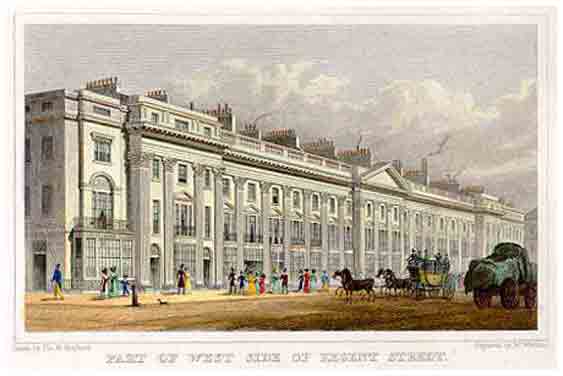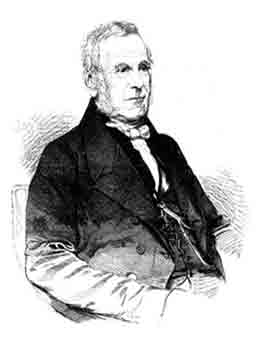1825-1833
When the Feildings returned to England, Amélina was a woman in her mid-twenties, tied closely to the family through four years of shared experiences, confident in society, and forthright in her opinions concerning art, politics and people, her command of English and Italian now sure enough to allow her to fall into either language when it seemed appropriate. Equally Caroline and Horatia were now no longer children, but young ladies, ready to be presented at court.
In London she found “smoke, fog etc, as usual” but also “the city much improved by a superb street which crosses a great part of it, called Regent Street”. Here they mixed with the same society and saw the same operas, sung by the same singers, as they had been enjoying on the Continent.

London scene. The Feildings and the Fox Talbots owned a house in Sackville Street and shopped in Regent Street.
“We went to the opera in Mrs Hope’s box, expecting to see Semiramide, but a notice inside announced Otello. The public who had not seen the notice (put up very late according to what is said) rose suddenly in indignation when the curtain, rising, displayed St. Mark’s Square, the Doge, and the Venetian Senate, then cries of off! off! broke out on all sides...and after many coming and goings a young man appeared who explained, that because of a dispute with Mme Vestris they were not able to give Semiramide that evening. The debate lasted an hour and a quarter, some making speeches and interrogating and shouting at the poor substitute for Mr Ebers, whom they had not been able to find; others calling out to proceed, others persisting in rejecting Otello and wanting what they called an apology on the part of the director. Finally after a last attempt by the young man, sent no doubt by Mr Ebers, whom they claimed not to be able to find, the Opera was allowed to begin, and the rest of the piece passed quietly. Mme Pasta sang divinely, but did not act as well, it seemed to me, as in Paris.”
For two years they lived mainly in London, while Amélina saw and commented on everything: Hampton Court; the new Horticultural Gardens; the elder Brunel’s Thames Tunnel then under construction; Charles Kemble as Mark Antony; Edmund Kean as Othello; Sir Thomas Lawrence’s studio; every possible art exhibition.
“Wednesday, 30 August [1826]. Saw the tunnel under the Thames. It is a very bold enterprise to have a passage under such a river: the work is proceeding, however they have not yet made great progress. [As Amélina explains in a note at the bottom of the page, the following section is "in Admiral Feilding's handwriting"] They have only arrived at the perpendicular of the line of low tide. However it does not seem that there will be any difficulty greater than those which they have already overcome. The success of the enterprise is mainly due to the talents of M. Brunel, a French engineer, long established in England, who has invented a totally new machine for protecting the workmen from the danger of being crushed by a fall of earth, or from being drowned if by chance they encountered a spring. [End of Feilding's entry] I admit that in spite of this concern with safety, I was quite ill at ease in this new kind of cave: there are two galleries side by side, one for carriages, the other for pedestrians. The entrance, a big archway, is round, and the building of a wall of bricks, to which a stairway will be fixed, seems like a marvel, since it has been built before the digging was done, and it has been lowered as a whole as space was made for it; and it has been found to be of the correct height and of such strength, that you cannot even see one crack.”

Sir Mark Brunel ( 1769-1849) built a tunnel under the Thames in 1825-41.
From time to time they rented houses in Bristol, Worthing and Brighton for extended stays, but at last, in August 1827, they were able to take possession of the Lacock estate, and during their first winter there, they established a new life of local visits, village charity, and country pursuits which Amélina unexpectedly enjoyed.
Lady Elisabeth’s sister Louisa had married the Marquess of Lansdowne, and was consequently the mistress of Bowood House, a few miles from Lacock. The two families exchanged visits constantly. One significant consequence was the frequent company of Thomas Moore, the Irish poet, who lived nearby and was much prized at Bowood. Another was a closer acquaintance with English politics due to Lord Lansdowne’s importance as a member of successive governments, and later, to Henry Talbot’s brief term as MP for Chippenham from 1832. Amélina had always recorded political events in her journal, but while French and Russian politics were probably gleaned from the newspapers, English politics, and particularly the events leading up to the Catholic Emancipation and Reform Bills are often reported from personal knowledge, both in Wiltshire and in London.

Henry Petty-Fitzmaurice,
Marquis of Lansdowne, K.G. (1780-1863).
They did, however, belong to grand social circles, and the exchange of visits with Lord and Lady Wilton of Heaton Hall, Lord Molyneux, the heir of Croxteth, whom Mary eventually married, and the Stanleys of Knowsley, together with race meetings, and holidays in the Lake District and Anglesey, provided Amélina with lively material for her diary. However, in 1831, her health broke down, and in September of that year she fled to Lacock to recuperate. “I crept about in the garden, for that is all I am able to do...I have only a faint hope that I shall ever recover.”
She improved only slowly, but began to enjoy herself once more. “10 January 1832. Breakfast for 12 people ranked round the table. Mr. Moore went to Sloperton to write; he is returning for dinner. Music in the evening. Caroline charming in a gown of black velvet with gold jewels. Miss Isabella played divinely on her guitar which Mr. F. had fetched from Farley Castle. Sang w. Moore and Lord V. Miss Elisa Holton has great pretensions in music. She sang two songs of her compositions.”

Dining Room, Lacock Abbey.
Soon she was totally absorbed in the engagement and marriage of Caroline Feilding to Lord Valletort, heir to the Earl of Mount Edgcumbe, godson and aide-de-camp to William IV, which took place in December in the chapel at Bowood.
By March 1832, Amélina was well enough to travel to Paris, to spend several months with her family. On her return she enjoyed a short time in Lacock and London with the Feildings, remaining until after Caroline gave birth to her first son in November (“one of the sweetest moments of my life”). She returned to Hopwood, but in January 1833 was delighted to received an invitation from Henry Talbot, (who had recently been elected MP for Chippenham, and married) to join him and his bride on a continental tour.
